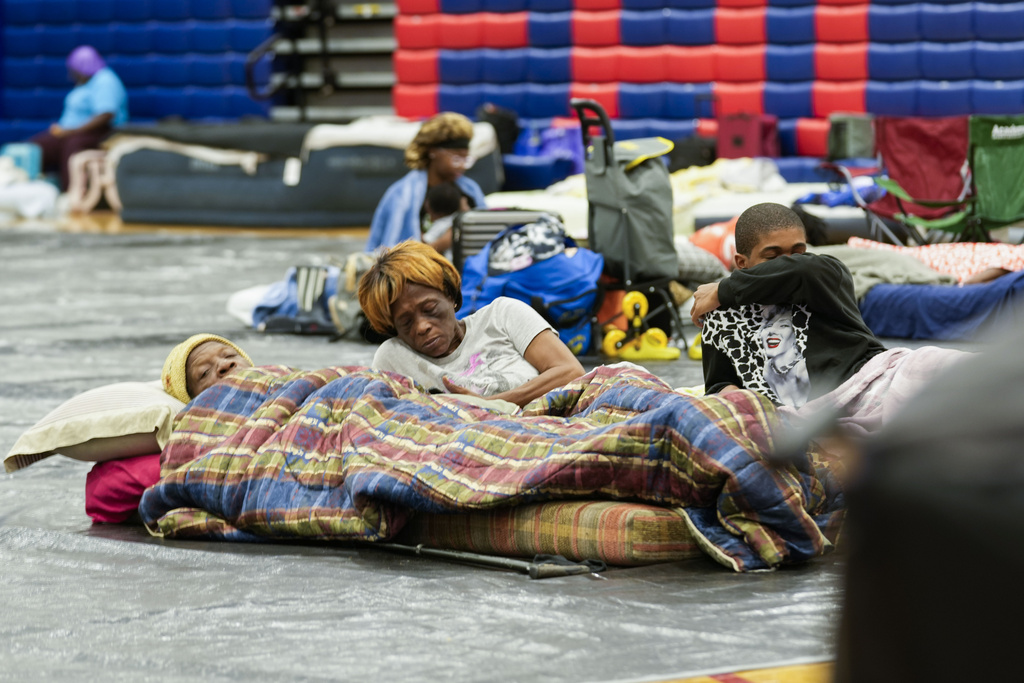Fast-Moving Hurricane Helene Targets Florida With High Winds \ Newslooks \ Washington DC \ Mary Sidiqi \ Evening Edition \ Hurricane Helene, upgraded to a Category 3 storm, is barreling across the Gulf of Mexico towards Florida, threatening catastrophic storm surges and heavy rains across the Southeast. Governors in Florida, Georgia, and the Carolinas declared states of emergency, with evacuations underway in vulnerable areas. Helene’s far-reaching impact could bring damaging winds and flash flooding hundreds of miles inland.

Hurricane Helene Threatens Catastrophic Surge: Quick Looks
- Category 3 Storm: Hurricane Helene has strengthened into a major Category 3 storm as it moves across the Gulf of Mexico, expected to make landfall on Florida’s northwestern coast Thursday evening.
- Evacuations and Curfews: Governors in Florida, Georgia, and the Carolinas have declared states of emergency, with curfews and evacuations in place across several regions. In south Georgia, cities like Valdosta and Albany have imposed overnight curfews to ensure public safety.
- Storm Surge Warning: Helene threatens catastrophic storm surges of up to 20 feet in parts of Florida’s Big Bend region. Officials are warning residents who haven’t evacuated to stay off the roads and brace for power outages.
- Historic Flooding Forecast: North Carolina is preparing for potentially historic flooding as Helene’s remnants move inland. Forecasters are predicting an additional 9 to 14 inches of rain, which could bring the worst flooding in the region since 1916.
- University Shelters Activated: Students at Florida State University and Florida A&M University were relocated to shelters in Tallahassee, where officials prepared for extreme weather conditions as the storm approaches.
- Rural Florida Officials’ Dire Warning: In Taylor County, Florida, officials warned those who remained that they may be putting first responders’ lives in danger and should write identifying information on their bodies in case of emergency.
- Powerful Winds and Widespread Damage: The hurricane is expected to bring damaging winds and flash floods to a wide area, with winds exceeding 111 mph. Inland areas like South Georgia and parts of the Carolinas are bracing for extended power outages.
Deep Look:
Hurricane Helene, now classified as a powerful Category 3 storm, is rapidly advancing across the Gulf of Mexico toward Florida’s northwestern coast, carrying with it the potential for catastrophic damage. With landfall expected by Thursday evening, the massive storm poses a serious threat to coastal and inland regions alike, from Florida up through Georgia and the Carolinas, prompting widespread evacuations and states of emergency across the southeastern United States.
Landfall Imminent in Florida’s Big Bend
Helene is on track to slam into Florida’s Big Bend region, an area that has seen major storm impacts in the past but is now preparing for what could be the most devastating storm surge in years. The U.S. National Hurricane Center has forecast storm surges up to 20 feet, with the possibility of flooding miles inland. Florida Gov. Ron DeSantis warned that Helene is expected to bring damaging winds and torrential rains to a large portion of the state, urging residents in the storm’s path to take evacuation orders seriously.
In the small fishing village of St. Marks, local fisherman Philip Tooke and his crew were preparing to ride out the storm on their boats, despite knowing the risks. As Tooke explained, his boats are his livelihood, and if they are destroyed, he will lose everything. Meanwhile, authorities in Wakulla County, also in the Big Bend area, are anticipating a long road to recovery once the storm passes.
Severe Flooding Expected in the Carolinas
Further north, residents of North Carolina are bracing for unprecedented flooding as the storm’s remnants head inland. Forecasts predict an additional 9 to 14 inches of rain in areas already saturated by recent storms, bringing rivers like the French Broad and Swannanoa to levels not seen in over a century. Emergency officials warned of potentially life-threatening floods, mudslides, and power outages as heavy rains sweep across the region, threatening homes, businesses, and roadways.
“This is not a maybe. This is on track to happen,” Buncombe County Emergency Services Director Taylor Jones emphasized, urging residents in Asheville and surrounding areas to prepare for the worst. Floodwaters have already begun rising, with the potential for further disaster looming as the hurricane pushes northward.
Precautions in Georgia and Other States
In Georgia, where officials expect Helene to continue its path of destruction, Gov. Brian Kemp described the storm as one of the largest in the state’s history. Emergency shelters have been opened in the southern parts of Georgia, while curfews have been imposed in areas like Albany and Valdosta. The storm’s high wind speeds and torrential rains are expected to bring down power lines and uproot trees, leaving many areas without power for days.
State emergency teams, along with 30 American Red Cross units, are on standby to provide immediate assistance, with officials predicting significant damage across the state as Helene barrels through South Georgia and heads towards the Carolinas. “This is one of the biggest storms we’ve ever had,” Kemp said, highlighting the widespread nature of the storm’s wind field.
Helene’s Impact Far Beyond the Coast
While much of the attention has been focused on the storm’s impact along Florida’s coastline, Helene is set to bring destruction far inland. The storm is expected to carry hurricane-force winds hundreds of miles from the coast, with power outages anticipated across Georgia and the Carolinas. Officials in states as far north as Virginia are preparing for the storm’s effects, with FEMA Administrator Deanne Criswell warning that Helene will be a multi-state event.
“The severity of extreme weather has led us to deploy more resources ahead of time,” Criswell said during a press briefing, noting that FEMA has pre-positioned food, water, and rescue teams across the region. Power restoration crews have also been dispatched to ensure that resources are in place as soon as the storm passes.
Warnings for Residents Who Stayed Behind
In rural Taylor County, Florida, where Helene is expected to make landfall, local officials issued a dire warning to those who chose not to evacuate. In a social media post, the sheriff’s office advised residents to write identifying information on their bodies in permanent marker in case of an emergency. They also warned that essential services like food, water, and electricity would likely be unavailable for days after the storm.
For those who evacuated, authorities cautioned patience upon returning to their homes, as fallen trees and flooded roadways will likely slow the recovery process. Similarly, Cedar Key, a small island community southwest of Gainesville, is facing an imminent threat from both the storm surge and debris from a recent fire, which has already begun washing ashore.
A Storm for the History Books
Hurricane Helene’s strength, size, and inland reach are making it one of the most dangerous storms to hit the southeastern U.S. in recent memory. With tropical storm warnings stretching from Florida to North Carolina, and concerns over record-breaking flooding and widespread power outages, Helene is poised to leave a lasting mark on the region.
As Florida officials coordinate with federal emergency agencies, the next 24 hours will be critical in determining the extent of the storm’s damage. Helene’s combination of hurricane-force winds, life-threatening storm surges, and torrential rains will undoubtedly test the readiness and resilience of the southeastern United States.
Fast-Moving Fast-Moving Fast-Moving Fast-Moving







